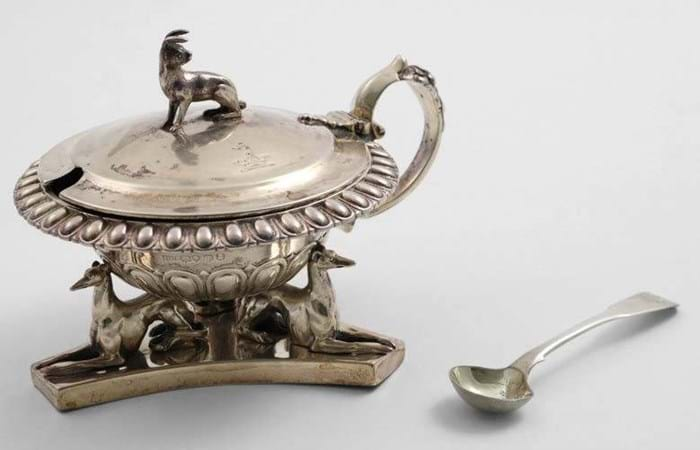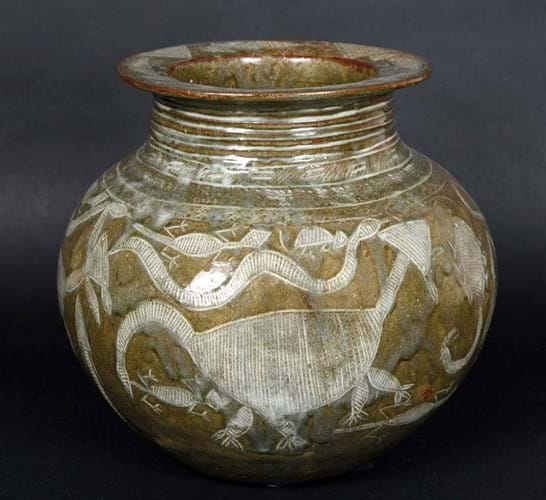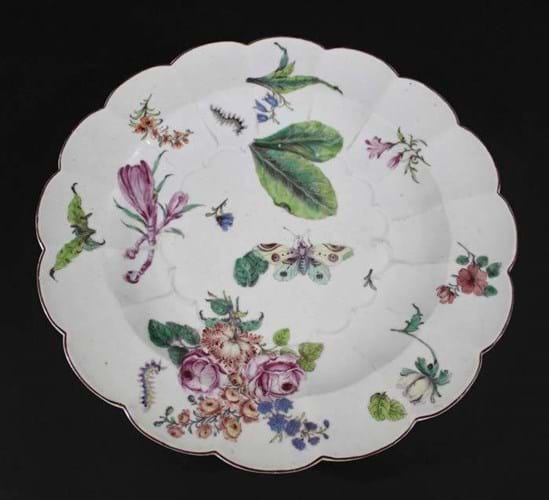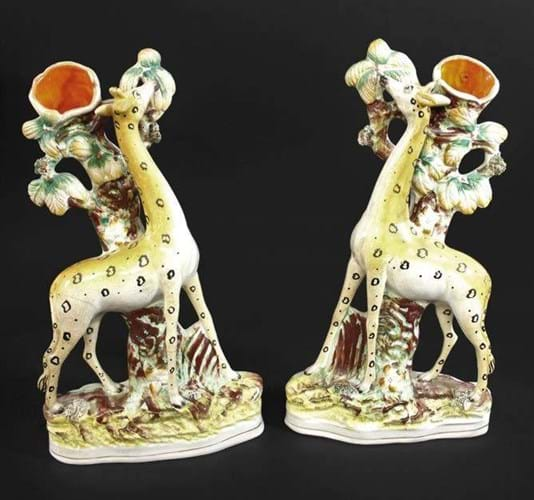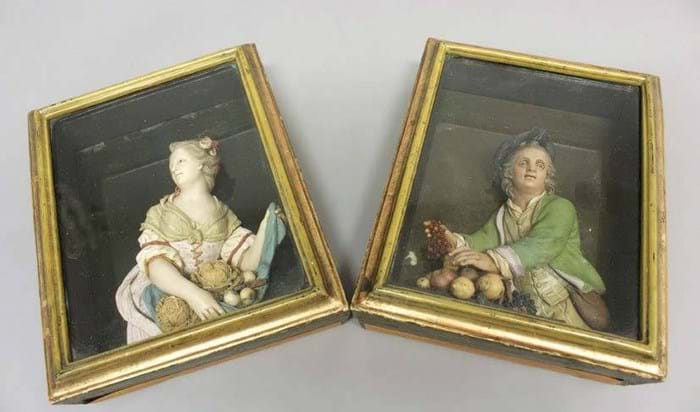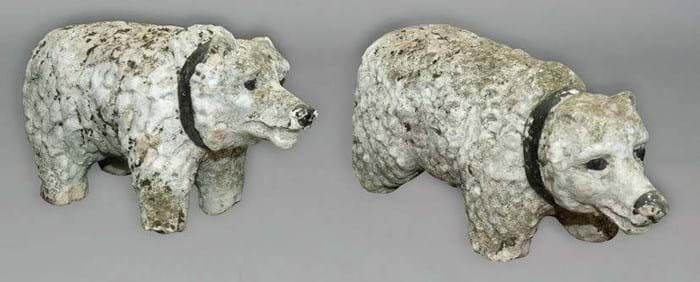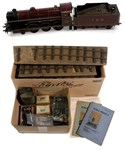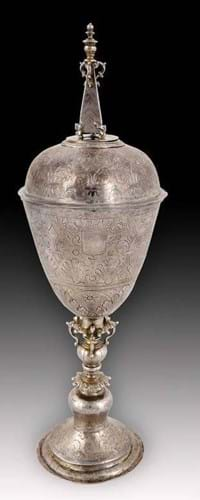
Steeple cups, named after their pyramidal finial, are a distinctly English form.
Popular in the first half of the 17th century, late Elizabethan and Jacobean inventories record gilded cups or ‘bolles’ with a steeple or pinnacle used in a domestic setting for feasting and display, sometimes supplied in sets of three.
They were the subject of an exhaustive study by the academic Norman Penzer (1892-1960), who found all surviving examples dated from 1599-1646.
Although thought to have been made for a secular context, most survivors were those that escaped the English Civil War melting pot only after being adapted for church use.
Like all pre-civil war hollowwares, they make only rare appearances on the market. The last to sell at auction was the James I silver gilt example with the maker’s mark TF, probably for Thomas Francis (London 1611), which took £75,000 as part of the David Little collection at Christie’s in 2019. It was previously owned by newspaper proprietor Harold Harmsworth, 1st Viscount Rothermere.
Turbulent priest
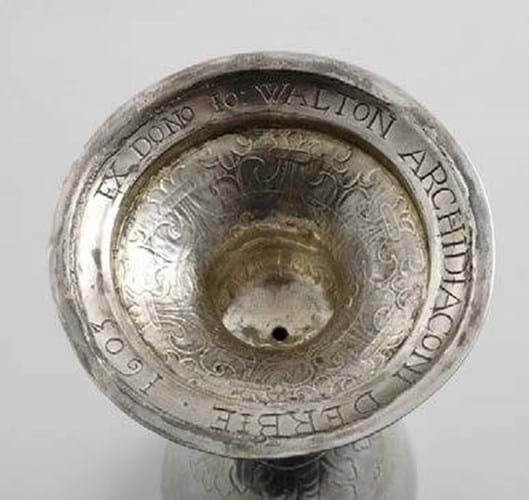
A detail of the inscription to the Elizabeth I silver steeple cup sold at Lawrences of Crewkerne.
The Silver & Vertu sale at Lawrences (25% buyer’s premium) in Crewkerne on July 20 included a 17in (42cm) high Elizabeth I steeple cup and cover with the maker’s mark AB conjoined (pictured top). The date letter for London 1602 makes it one of the earliest extant.
According to an inscription to the foot reading Ex Dono Io Walton Archidiaconi Derbie 1603, its first owner had been John Walton, an Anglican priest educated at Oxford who served as the Archdeacon of Derby from 1590-1603. His tenure was not without incident: papers in the library at Lambeth Palace accuse him of ‘adultery, non-residence, simony, abusing ministers in his court, accepting bribes and imposing unlawful oaths on the apparitors of his court’.
More recently, the cup was given as the prize to the grandfather of the owner whose horse Don Sancho won the Irish Grand National in 1928. A small silver disc detailing the presentation is soft soldered to the base. It came for sale in Somerset with an estimate of £30,000-40,000 and got away to a UK private collector at the lower guide.
Car boot spoon find
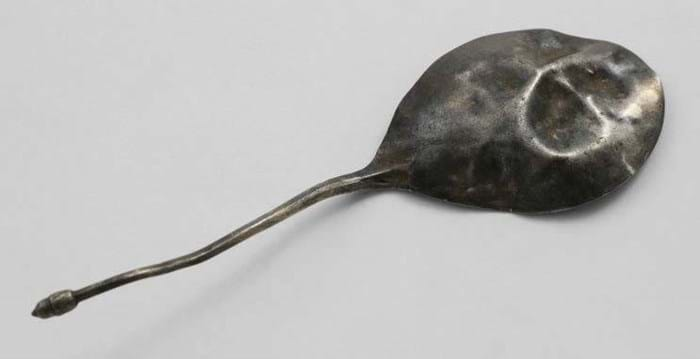
Medieval silver acorn knop spoon in excavated condition – £1900 at Lawrences of Crewkerne.
The silver sale at Crewkerne was also notable for a remarkable car boot sale find: a small acorn knop spoon, c.1300-1400.
It was in a crushed and contorted state consistent with having been buried or submerged in a river but was clearly worth the 20 pence the vendor had paid for it.
The acorn knop is among the earliest forms of post- Roman silver spoons, with most examples dating from the beginning of the 14th century. The first known mention of the type appears in a will of 1348, in which one John de Holegh bequeathed to Thomas Tailor his ‘twelve best spoons with gilt akernes’.
A great example can bring five figures but this one, measuring 5in (12cm) long and weighing just one third of an ounce, was guided at £500-700 and sold to a UK private for £1900.
A strong bid of £4000 (estimate £500-700) came from an overseas buyer for a rare George IV mustard pot by Benjamin Preston, London 1827. Modelled on a coursing theme with a hare finial and three greyhounds to a tricorn base, this had perhaps been made as a competition trophy and was clearly a form few mustard pot collectors owned.
Also performing well was a Channel Islands baluster form mug, c.1780, with marks for Pierre Amiraux (1726-1808) of Jersey and ownership initials Don de I DLP a P VB (£5000) and a Queen Anne tankard engraved with the arms and coronet of a baron, the initials H over CP and the marks for John Langwith, York 1709 (£3600).
Ceramics array

A 1984 terracotta vase by Dame Magdalene Odundo – £94,000; and a smaller vase dated 1984 – £21,000, both at Lawrences of Crewkerne.
Silver and vertu had followed a very broad-ranging ceramics offering on July 19 where post-war studio wares rubbed shoulders with early English and Welsh porcelain and Chinese works of art.
Buoyed by the success of recent exhibitions at Hepworth Wakefield and Salon 94 in New York, pots by Kenyan-born potter Dame Magdalene Odundo (b.1950) now enjoy the sort of financial rewards shared only by the likes of Hans Coper and Lucie Rie.
In November 2020, the London studio ceramics specialist auction house Maak achieved a world record for a living ceramic artist with the sale of the 1988 Angled Mixed Coloured Piece. Selling at £200,000, it also became the second most expensive piece of British studio pottery next to a £305,000 cycladic form by Coper sold by Bearnes Hampton & Littlewood in 2018. In a follow-up sale in May similar vessels from 1991 (both with small condition issues) sold at £80,000 and £105,000.
Two pieces by Odundo from the mid 1980s featured at Crewkerne on July 19. A 13½in (34cm) coil built burnished terracotta vessel combined a globular body with an oval shaped neck inspired by exaggerated African angular coiffeur. With incised marks to the base, Odundo, 1985, it was guided at a modest £5000-7000 but sold overseas at £94,000.
From the same vendor was a smaller 9in (22cm) terracotta vase of globular form with a burnished and carbonised glaze from 1984. Guided at £3000-5000, it took £21,000.
Both pieces came from a Somerset single-owner collection of studio wares.
Sold to a collector for £3400 (estimate £300-500) was a 13in (33cm) hand-built stoneware vase from the Abuja Pottery in Nigeria. Bearing seal marks for the most celebrated local practitioner Ladi Kwali (1925-84), it dated from the 1960s when, sponsored by the Nigerian authorities, the pottery was overseen first by Michael Cardew (from 1950-65) and then by Michael ‘Seamus’ O’Brien until 1972.
These large water pots, incised with stylised animals including snakes, lizards and fish, are the signature wares and the type of object shown at exhibitions in Lagos, London and Europe.
English porcelain
Topping the English porcelain was a large Chelsea Red Anchor dish, c.1752-56, painted with various botanical specimens, a butterfly and caterpillars.
Subjects such as this are sometimes referred to as ‘Hans Sloane’ Chelsea – a reference to an advertisement in Faulkner’s Dublin Journal of July 1-4, 1758, announcing ‘…table plates, soup plates and desart plates enamelled from Sir Hans Sloan’s plants’. Most botanical renderings on these Chelsea pieces were taken from illustrations in Philip Miller’s Gardener’s Dictionary depicting specimens from Sloan’s Physic Garden.
Plates of this type appear on the market with some frequency but a lobed-form dish such as this example measuring 13in (32cm) are a rare find. Last on the market in 1974 when it sold at Sotheby’s (the original catalogue was included in the lot), it was estimated to bring £500-700 and sold to a UK collector at £10,500.
Welsh highlights
A fine example of Welsh porcelain came from the same old collection. As detailed to a handwritten label verso, this 9in (23cm) square dish painted in the centre with a standing bird within a border of flowers and shells was part of the celebrated Nantgarw Mackintosh service commissioned by the Priest Richards family of Plâs Newydd near Cowbridge and later presented to Ella Priest Richards on the occasion of her marriage to The Mackintosh of Mackintosh of Moy Hall, Inverness.
It and similar services were probably London-decorated in the workshop of Thomas Martin Randall of Barnsbury Street, Islington, and retailed by Mortlock’s.
A similar dish to this one with some restoration to a break sold for £1500 at Rogers Jones in Cardiff in April this year. The example at Lawrences was in good condition (only slight wear to gilding and the dulling of some enamels counted against it) and it also had the bonus of a collection label for Cyril Kieft, a noted Swansea industrialist who built a large collection of Swansea and Nantgarw. This lot was purchased at Sotheby’s in May 1973 and was sold with the original catalogue to a collector for £3000.
A collection of mid-19th century Staffordshire animal models included both a pair of 6in (16cm) elephant spill vases sold at £280 and a pair of the desirable giraffe spill vases – the larger of this model at 13in (33cm) high – that brought £2400.

Pair of Ault vases to a Dresser design – £5500 at Lawrences of Crewkerne.
A very different example of Victorian pottery was a pair of 9in (22cm) high green-glazed Ault vases to a design by Christopher Dresser.
Only a handful of pieces of this early 1880s form (a bowl with an overarching handle) are recorded and there would have been a socially distanced queue a mile long to buy them at the estimate of £80-120. Instead they sold at £5500 – a sum that was still not beyond the pale.
Quirkier lots
Among the furniture and works of art offered on the final day at Lawrences on July 23, it was some of the quirkier lots that stood out.
A pair of wax relief studies of a gentleman in a green jacket selling fruit, and a lady carrying vegetables in her apron dated to c.1800 and were attributed to Caspar Bernard Hardy (1726-1819).
The vicar of the cathedral in his home town of Cologne, he was well known as the maker of these portrait reliefs depicting local types and personalities. Goethe praised them in On Art and Antiquity and visited the “strange but cheerful 80-year-old old man” during a trip to the Rhine in July 1815.
Both framed and glazed, and measuring 8½ x 7in (21 x 17cm), they were guided at £300-400 but took £2200.
Also popular were a pair of naive Victorian stone carvings of bears, both modelled standing on all fours with collars and open mouths. They had been painted black and white. By repute this pair of charming sculptures, each around 3ft (90cm) tall, were previously at Forty Hill House, Enfield. Pitched at £600-1000, they were sold at £3000.
Both lots went to UK private buyers.


